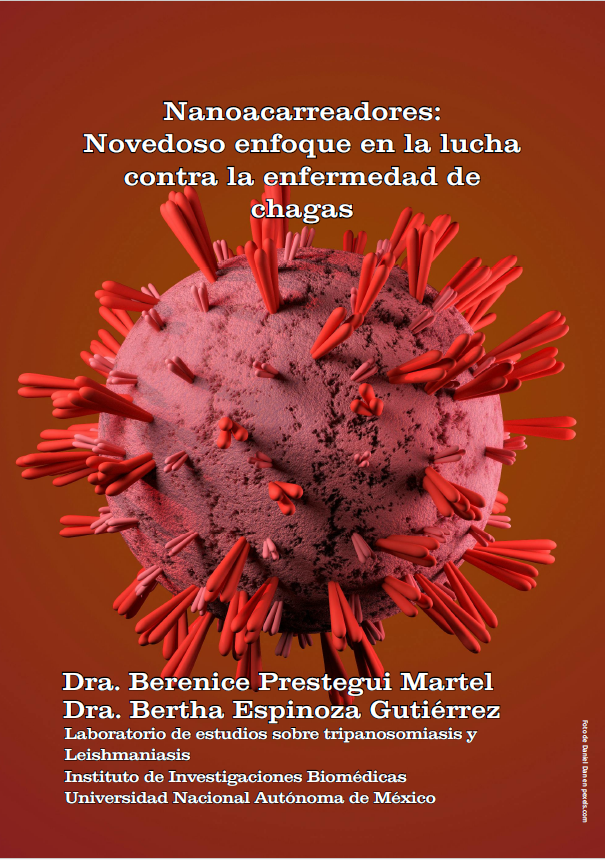Nanoacarreadores
Novedoso enfoque en la lucha contra la enfermedad de chagas
Keywords:
Chagas disease, nanoparticles, virus-like particles, Trypanosoma cruzi
Abstract
Chagas disease is a little known disease, transmitted by a parasite named Trypanosoma cruzi. In 2005, the World Health Organization declared it a neglected disease, which contributed to spreading knowledge about the characteristics of the disease, as well as supporting scientific research into new and better treatments, early diagnosis, detection and care of people with the disease. In the field of scientific research, particles smaller than viruses are being studied, in order to efficiently carry already tested drugs; but also with the application of this nanotechnology, to the use of nanocarriers that manage to reach the parasite and modify its way of reproduction or infection, thus fighting the disease.
Downloads
Download data is not yet available.
References
Britto Hurtado, R., Cortez Valadez, M., & Flores Acosta, M. (2022). Aplicaciones tecnológicas de las nanopartículas en la medicina e industria. Epistemus, 16(33).
Cárdenas-Guerra, R. E., Moreno-Gutierrez, D. S., Vargas-Dorantes, O. J., Espinoza, B., & Hernandez-Garcia, A. (2020). Delivery of antisense DNA into pathogenic parasite Trypanosoma cruzi using virus-like protein-based nanoparticles. Nucleic acid therapeutics, 30(6), 392–401.
Jekhmane, S., de Haas, R., Paulino da Silva Filho, O., van Asbeck, A. H., Favretto, M. E., Hernandez Garcia, A., Brock, R., & de Vries, R. (2017). Virus-like particles of mRNA with artificial minimal coat proteins: particle formation, stability, and transfection efficiency. Nucleic acid therapeutics, 27(3), 159–167.
Juárez-Chávez, L., Pina-Canseco, S., Soto-Castro, D., Santillan, R., Magaña-Vergara, N. E., Salazar-Schettino, P. M., Cabrera-Bravo, M., & Pérez-Campos, E. (2019). In vitro activity of steroidal dendrimers on Trypanosoma cruzi epimastigote form with PAMAM dendrons modified by "click" chemistry. Bioorganic chemistry, 86, 452–458.
Morilla, M. J., Romero, E. L. (2015). Nanomedicines against Chagas disease: an update on therapeutics, prophylaxis and diagnosis. Nanomedicine, 10(3), 465–481.
Muraca GS, Talevi A, Pesce GO. (2020). Enfermedad de Chagas: novedades en naomedicinas como estrategia terapéutica. Ciencia Reguladora, Abr (6): 32-37.
Pautler, M., & Brenner, S. (2010). Nanomedicine: promises and challenges for the future of public health. International journal of nanomedicine, 5, 803–809.
Scalise ML, Arrúa EC, Rial MS, Esteva MI, Salomon CJ, Fichera LE. (2016). Promising efficacy of benznidazole nanoparticles in acute Trypanosoma cruzi murine model: In-vitro and in-vivo studies. Am J Trop Med Hyg, Aug 1;95(2):388–393.
Silva, J. J., Guedes, P. M., Zottis, A., Balliano, T. L., Nascimento Silva, F. O., França Lopes, L. G., Ellena, J., Oliva, G., Andricopulo, A. D., Franco, D. W., & Silva, J. S. (2010). Novel ruthenium complexes as potential drugs for Chagas's disease: enzyme inhibition and in vitro/in vivo trypanocidal activity. British journal of pharmacology, 160(2), 260–269.
Stass, H., Ince, I., Grossmann, U., Weimann, B., & Willmann, S. (2022). Nifurtimox for treatment of chagas disease in pediatric patients: the challenges of applying pharmacokinetic-pharmacodynamic principles to dose finding. The AAPS journal, 24(5), 92.
Cárdenas-Guerra, R. E., Moreno-Gutierrez, D. S., Vargas-Dorantes, O. J., Espinoza, B., & Hernandez-Garcia, A. (2020). Delivery of antisense DNA into pathogenic parasite Trypanosoma cruzi using virus-like protein-based nanoparticles. Nucleic acid therapeutics, 30(6), 392–401.
Jekhmane, S., de Haas, R., Paulino da Silva Filho, O., van Asbeck, A. H., Favretto, M. E., Hernandez Garcia, A., Brock, R., & de Vries, R. (2017). Virus-like particles of mRNA with artificial minimal coat proteins: particle formation, stability, and transfection efficiency. Nucleic acid therapeutics, 27(3), 159–167.
Juárez-Chávez, L., Pina-Canseco, S., Soto-Castro, D., Santillan, R., Magaña-Vergara, N. E., Salazar-Schettino, P. M., Cabrera-Bravo, M., & Pérez-Campos, E. (2019). In vitro activity of steroidal dendrimers on Trypanosoma cruzi epimastigote form with PAMAM dendrons modified by "click" chemistry. Bioorganic chemistry, 86, 452–458.
Morilla, M. J., Romero, E. L. (2015). Nanomedicines against Chagas disease: an update on therapeutics, prophylaxis and diagnosis. Nanomedicine, 10(3), 465–481.
Muraca GS, Talevi A, Pesce GO. (2020). Enfermedad de Chagas: novedades en naomedicinas como estrategia terapéutica. Ciencia Reguladora, Abr (6): 32-37.
Pautler, M., & Brenner, S. (2010). Nanomedicine: promises and challenges for the future of public health. International journal of nanomedicine, 5, 803–809.
Scalise ML, Arrúa EC, Rial MS, Esteva MI, Salomon CJ, Fichera LE. (2016). Promising efficacy of benznidazole nanoparticles in acute Trypanosoma cruzi murine model: In-vitro and in-vivo studies. Am J Trop Med Hyg, Aug 1;95(2):388–393.
Silva, J. J., Guedes, P. M., Zottis, A., Balliano, T. L., Nascimento Silva, F. O., França Lopes, L. G., Ellena, J., Oliva, G., Andricopulo, A. D., Franco, D. W., & Silva, J. S. (2010). Novel ruthenium complexes as potential drugs for Chagas's disease: enzyme inhibition and in vitro/in vivo trypanocidal activity. British journal of pharmacology, 160(2), 260–269.
Stass, H., Ince, I., Grossmann, U., Weimann, B., & Willmann, S. (2022). Nifurtimox for treatment of chagas disease in pediatric patients: the challenges of applying pharmacokinetic-pharmacodynamic principles to dose finding. The AAPS journal, 24(5), 92.

Published
2025-04-09
How to Cite
Prestegui Martel, B., & Espinoza Gutiérrez, B. (2025). Nanoacarreadores: Novedoso enfoque en la lucha contra la enfermedad de chagas. Contactos, Revista De Educación En Ciencias E Ingeniería, (141), 37 - 44. Retrieved from https://contactos.izt.uam.mx/index.php/contactos/article/view/518
Section
Artículos





